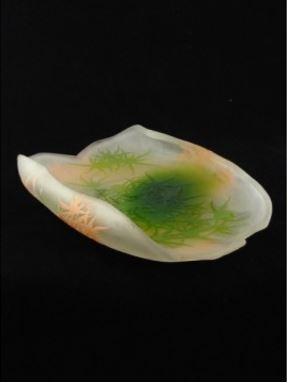
This object is eligible for a Certificate of BADA Provenance
The BADA Standard
- Since 1918, BADA has been the leading association for the antiques and fine art trade
- Members are elected for their knowledge, integrity and quality of stock
- Our clients are protected by BADA’s code of conduct
- Our dealers’ membership is reviewed and renewed annually
- Bada.org is a non-profit site: clients deal directly with members and they pay no hidden fees
Arts and Crafts hammered silver bowl with strap side handles to each side. The beautiful border is composed of applied rosettes. The bowl sits on a circular spreading base. Hallmarked Birmingham 1918 A E Jones. Excellent original condition
History
The Arts and Crafts movement was an international movement in the decorative and fine arts that began in Britain and flourished in Europe and North America between about 1880 and 1920. It stood for traditional craftsmanship using simple forms, and often used medieval, romantic, or folk styles of decoration. The movement had an “extraordinary flowering” in Scotland where it was represented by the development of the ‘Glasgow Style’ which was based on the talent of the Glasgow School of Art. Structured more by a set of ideals than a prescriptive style, the Movement took its name from the Arts and Crafts Exhibition Society, a group founded in London in 1887 that had as its first president the artist and book illustrator Walter Crane. The Society’s chief aim was to assert a new public relevance for the work of decorative artists (historically they had been given far less exposure than the work of painters and sculptors).
Albert Edward Jones: was born in 1878 into a family of craftsmen dating back to 1780, and died in 1954. "A piece of silverwork to be really interesting must be endued with a Spirit of Art....." A E Jones 1906 Apprenticed to Woodwards then Hardman Powells, and trained at the Birmingham Central School of Arts, under Edward Taylor he gained a reputation as a developer and innovator . He worked as a Guildsman at the Birmingham Guild of Handicraft where he was influenced by the Arts and Crafts Movement and met many artists and designers. Having made some bronzeware at his father's premises he left the family metalwork business and set up on his own in 1902. Success came quickly, the workshop attracting a talented group of artists and craftsmen inspired by the Arts and Crafts movement. In 1905 he acquired Jesson and Birkett with its trade mark of St. Dunstan hand-raising a bowl. He collaborated with Edward Taylor's son Howson, owner of Ruskin Pottery, in mounting and using the coloured pottery as liners for some of his silverwork which at this time was all hand raised. The company produced many clock cases with French movements and a considerable amount of Ecclesiastical work. In 1958 his son Kenneth Crisp Jones (also trained at the Central School of Art Birmingham) took over the business which has recently been acquired by C J Vander of Sheffield.
Date Birmingham 1918 A E Jones
Condition Excellent original condition
Dimensions Approximate width 19.5 cm and height 6 cm
Dimensions
Approximate width 19.5 cm and height 6 cmCondition report
Excellent original conditionStock number
2250The BADA Standard
- Since 1918, BADA has been the leading association for the antiques and fine art trade
- Members are elected for their knowledge, integrity and quality of stock
- Our clients are protected by BADA’s code of conduct
- Our dealers’ membership is reviewed and renewed annually
- Bada.org is a non-profit site: clients deal directly with members and they pay no hidden fees


